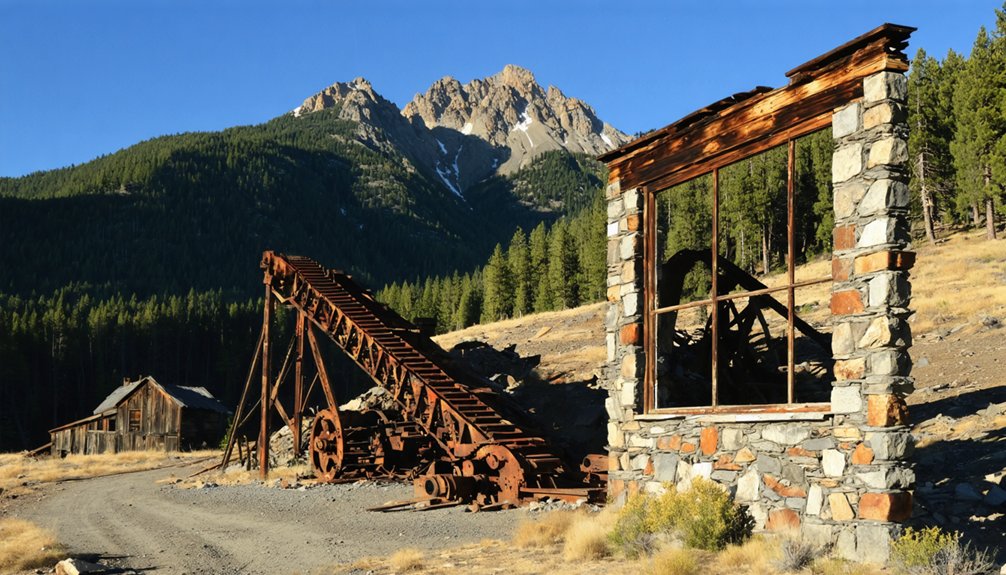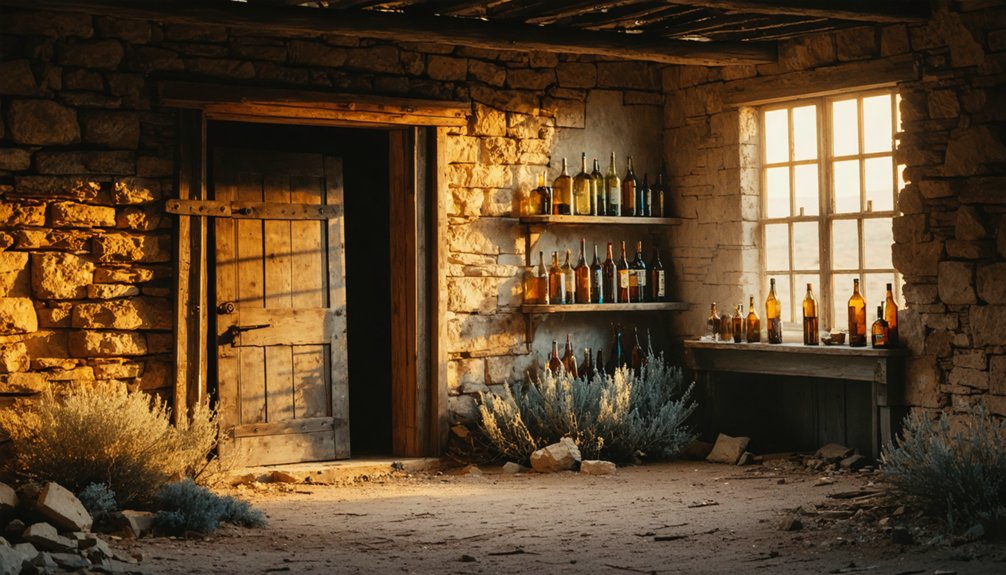You’ll find Landore nestled in Idaho’s remote Seven Devils copper district, where it flourished briefly from 1898 to the early 1920s. This mining boomtown attracted significant investment and established a smelter in 1904, drawing comparisons to Montana’s famous Butte district. Today, you can explore the scattered remains, including the iconic brick chimney and mining artifacts, but you’ll need a high-clearance vehicle for access between June and September. The site’s rich history reveals a fascinating chapter of Idaho’s copper mining era.
Key Takeaways
- Landore was established in 1898-1899 as a copper mining town in Idaho’s Seven Devils district near the Black Hills claim.
- The town’s peak came with a smelter construction in 1904, but its failure and incomplete railroad connections led to decline.
- Original log homes, mining structures, and a tall brick chimney remain as evidence of the town’s industrial and residential past.
- Best visitation time is June-September, requiring a high-clearance vehicle and detailed maps due to remote mountain location.
- The ghost town’s ruins include scattered mining tools, processing facilities, and a traceable main street layout from early 1900s.
The Mining Town’s Rise to Prominence
As mining prospects emerged in Idaho’s Seven Devils copper district, the town of Landore took shape around 1898-1899 near the Black Hills claim and Arkansas Mine. The settlement’s formation coincided with exciting developments in copper mining, drawing comparisons to Montana’s famous Butte copper district.
You’ll find that mining innovations quickly transformed this rugged terrain, characterized by high canyon walls of the Seven Devils range. British capital and outside investment fueled systematic mining operations, while community growth followed with the addition of essential infrastructure. These operations benefited from the same galena and chalcopyrite deposits found throughout Custer County’s mining districts.
The region’s geological makeup of dolomitic limestone and volcanic covers presented unique challenges, but by 1899, mining inspectors recognized the area’s exceptional copper wealth potential under capable management. The district’s promise attracted substantial investment, setting the stage for Landore’s brief but significant mining boom.
Life in Early Landore
When pioneers first settled in Landore during the late 1890s, they established a tight-knit community built on ranching and mutual support before mining became the town’s primary focus.
You’d have found pioneer families like the Stevensons living in sturdy log homes scattered across the open terrain, with blacksmith shops and the Junction Hotel serving as essential hubs of daily life.
Community gatherings, including basket socials and work parties, strengthened bonds between isolated homesteads. Similar to the Mormon pioneers who established Idaho’s first organized settlements, you could’ve witnessed a self-reliant lifestyle where residents combined cattle ranching with hunting, fishing, and small-scale farming to survive.
Travel relied on horse-drawn wagons until 1910’s railroad arrival, while the local post office kept you connected to the outside world despite the challenging terrain and weather.
The Smelter’s Brief Legacy
Though copper mining initially drove Landore’s growth, the establishment of a smelter in 1904 marked the town’s ambitious industrial peak.
The railroad project of 1898 attempted to connect this remote smelting operation to wider markets, but funding challenges prevented its completion.
You can still see the tall brick chimney standing as a symbol of the town’s brief industrial aspirations, where smelter technology transformed raw ore into valuable metals using intense heat.
The smelter’s legacy includes:
- Advanced processing capabilities that set Landore apart from smaller camps that shipped their ore elsewhere
- Limited environmental impact due to its short operational life, unlike the extensive pollution seen at other Idaho smelting sites
- A visible reminder of the challenges faced by remote mining operations in the rugged Seven Devils region
The smelter’s failure ultimately contributed to Landore’s decline, reflecting the volatile nature of frontier mining ventures.
Exploring the Historical Remains
Today you’ll find Landore’s historical remains scattered across the rugged Idaho mountainside, where weathered wooden frames and stone foundations tell the story of this once-bustling mining settlement.
As you explore, you’ll discover fascinating archaeological findings, including mining tools, household items, and personal effects that paint a vivid picture of pioneer life.
The site reveals late 19th and early 20th-century mining technology through its partially standing processing facilities and equipment relics.
You can still trace the town’s original layout along what was once the main street, though nature steadily reclaims the land.
While there’s no visitor center, you’ll need a high-clearance vehicle to access these remote ruins.
Similar to Silver City, which was established in 1864 as a mining town, Landore emerged during Idaho’s mineral boom era.
Like many Idaho boomtowns, Landore experienced rapid decline once the mines closed.
Watch for tailings piles and ore processing remnants that mark this memorial to Idaho’s mining heritage.
Seasonal Adventures and Access Tips
You’ll find the best conditions for exploring Landore between late spring and early fall, when snow-free trails and longer daylight hours enable hiking, ATV riding, and photography.
To reach this remote ghost town safely, you’ll need detailed maps, sturdy footwear, and weather-appropriate gear while respecting posted boundaries and established paths. Similar to the ghost town tourists who visited Bonanza for its preserved buildings and artifacts, many adventurers today seek out Landore’s historical remains.
Pack essential supplies including extra food, water, and emergency equipment, as mountain weather can change rapidly and services are limited in this rugged region of Idaho. Many visitors combine their ghost town exploration with outdoor recreational activities like hiking, fishing, and wildlife viewing in the surrounding wilderness.
Best Times to Visit
While Landore’s rugged beauty can be experienced year-round, the best window for visiting this Idaho ghost town falls between June and September. You’ll find ideal weather conditions during these months, with moderate temperatures and dry trails that make exploring the historic ruins both safe and enjoyable. The town’s Salmon National Forest headquarters history makes it an excellent base for outdoor enthusiasts. Originally established as a silver mining settlement, the site offers visitors a glimpse into Idaho’s rich mineral past.
- Summer months offer extended daylight hours and stable ground conditions, perfect for photographing the 1904 smelter chimney and examining the remaining cabin structures.
- Early fall (September) brings cooler hiking temperatures and spectacular foliage, though you’ll want to watch for early snowfall.
- Late spring visits require extra preparation, as melting snow can create muddy, rutted roads that often demand 4WD vehicles.
Avoid winter months between November and April when heavy snow typically blocks access to the site.
Getting There Safely
Reaching the remote ghost town of Landore requires careful planning and preparation, especially given the challenging terrain and unpredictable weather conditions.
You’ll need to navigate unpaved roads that are susceptible to washouts and potholes, particularly after rain or snowfall.
The best access window runs from late spring through early fall when road conditions are most favorable.
Winter visits often require snowmobiles or specialized vehicles.
Before heading out, check weather forecasts, as sudden storms can roll through the Seven Devils Mountains region.
You’ll want a high-clearance vehicle, preferably 4WD, and essential survival gear including water, food, and emergency supplies.
Bring a reliable GPS unit and topographic maps, as signage is minimal.
Always inform someone of your travel plans due to limited cell coverage.
Essential Trip Preparations
Proper preparation can make the difference between an enriching adventure and a challenging ordeal when visiting Landore’s ghost town ruins. When planning your trip, you’ll need to take into account the season and pack essentials accordingly, from layered clothing for spring and fall to insulated gear for winter explorations.
- Pack your survival basics: plenty of water, high-energy snacks, and a first aid kit with supplies for cuts and insect bites.
- Bring navigation tools like GPS devices or detailed maps, and don’t forget emergency communication equipment since cell service is unreliable.
- Carry weather-appropriate gear: sun protection for summer, waterproof layers for spring, and thermal wear for winter’s subfreezing temperatures.
Don’t forget your safety precautions – always inform someone of your plans and expected return time before heading out.
Preserving Idaho’s Mining Heritage

As Idaho’s rich mining heritage faces growing preservation challenges, several organizations work diligently to document and protect the state’s historic mining sites and cultural resources.
Since 1899, thorough mining documentation has captured the evolution of Idaho’s mineral industry, with the Idaho Geological Survey maintaining extensive archives of both published and unpublished materials.
You’ll find that preservation efforts extend beyond just record-keeping – the State Historic Preservation Office actively identifies and nominates significant sites to the National Register of Historic Places, while working closely with tribal groups and local governments to safeguard these irreplaceable landmarks.
The Idaho Mining Association partners with various agencies to promote responsible practices, ensuring that modern operations don’t compromise historic sites while supporting necessary environmental protections and reclamation efforts.
Frequently Asked Questions
Are There Any Reported Paranormal Activities or Ghost Sightings in Landore?
You won’t find documented ghost encounters or spectral sightings here. Unlike other Idaho ghost towns, there’s no historical evidence, visitor testimonials, or paranormal investigation reports suggesting supernatural activity in this location.
What Wildlife Species Can Visitors Commonly Encounter Around the Ghost Town?
While hiking trails around the area, you’ll spot elk, mule deer, and pronghorn in open areas. You’ll find great wildlife photography opportunities with red-tailed hawks soaring overhead and western meadowlarks in grasslands.
Was There Any Significant Gold Discovery in Landore’s Mines?
You’ll find no documented records of significant gold discoveries in this area, though mining techniques were employed. The focus was likely on other minerals common to Idaho’s mining operations.
Are Metal Detecting Activities Permitted Within the Ghost Town Boundaries?
Like a prospector seeking Sutter’s fortune, you’ll need explicit permission as metal detecting regulations protect historical artifacts here. Check land ownership and obtain proper permits before searching.
Did Any Notable Historical Figures or Outlaws Ever Visit Landore?
You won’t find any records of famous visitors or outlaw legends in Landore’s history. Available sources show it was primarily a small, workmanlike mining camp without documented visits from notable personalities.
References
- https://www.thegoldminehotel.com/ghost-towns-and-haunted-places-in-idaho
- https://idaho-forged.com/idahos-ghost-towns-eerie-yet-approachable/
- https://www.ghosttowns.com/states/id/landore.html
- https://www.youtube.com/watch?v=rTSZSlxTmbs
- https://visitidaho.org/things-to-do/ghost-towns-mining-history/
- https://www.onlyinyourstate.com/trip-ideas/idaho/bayhorse-ghost-town-id
- https://history.idaho.gov/wp-content/uploads/2018/12/0116.pdf
- https://westernmininghistory.com/library/38225/page1/
- https://history.idaho.gov/wp-content/uploads/2018/08/0009.pdf
- https://www.idahogeology.org/pub/Staff_Reports/2004/S-04-1.pdf



